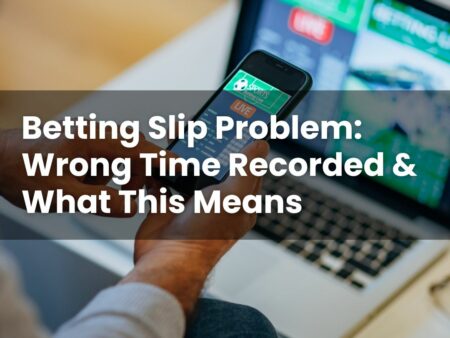Walking into a bookmaker for the first time, or placing a bet online, can feel a little confusing if you have not filled out a betting slip before. Whether you are watching the football with friends or simply curious about how bets are actually placed, understanding the slip is a useful starting point.
This guide breaks the process down into clear, simple parts so you know what to write, where to write it, and how it all gets processed. It also keeps things aligned with UK regulations, so you can approach the counter or the app with confidence. Read on to learn more.
What Is a Betting Slip and How Does It Work?
A betting slip is a paper form or digital panel where you set out your potential bet. It tells the bookmaker what event you are betting on, the amount you want to stake, and the type of bet you are choosing, such as a football match result or a horse to finish in a place.
On a paper slip, you will usually find boxes for the selection, the odds shown in the shop, and your stake. Some shops ask for extra detail like the race number or kick-off time to make sure there is no confusion. Once you have filled it in, you take it to the counter and the cashier processes it, then prints a receipt that confirms everything.
Online, the steps are similar but faster. You tap your selections on the site or app and they appear in a virtual betting slip. You review the details, check the potential return, and confirm. UK Gambling Commission (UKGC)-licensed bookmakers follow the same core rules whether they operate on the high street or online, so the fundamentals are consistent.
If you decide to try your hand at betting, remember to do so responsibly and within your means; never wager more than you can afford to lose.
How to Fill Out a Betting Slip Correctly
Writing Your Selection and Stake
Start by writing the exact selection as listed on the board or screen. Be specific. If it is horse racing, include the race time and the horse’s name. For football, write the teams and the market, such as Match Result or Both Teams To Score. Specifics prevent mix-ups.
Then add your stake, which is the amount of money you want to bet. Write it clearly with the pound sign, for example £5. Bookmakers often have minimum or maximum stakes, so if you are unsure, ask the cashier before you hand the slip over.
Choosing Between Win and Each-Way Bets
A win bet pays out only if your selection finishes first in the relevant market. An each-way bet, common in horse racing, covers two outcomes at once. Half your stake goes on the win, and half goes on the place, which usually means finishing in the listed places for that race.
Each-way terms are shown in the shop or online, for example 1/5 odds, places 1–3. These terms determine how the place part of your bet is settled. If you are betting each-way, make sure you tick the box or write it clearly on the slip so the cashier can process it correctly.
Checking the Odds and Potential Returns
Odds show how a bet will be paid if it wins. If the board shows 5/1 and you stake £5, the win part would return £25 plus your £5 stake. In shops, prices are displayed on screens or sheets and can move, especially close to the start of an event. Check again just before you write them down.
Online, potential returns are usually calculated automatically as you add selections to your slip. In a shop, staff can confirm the latest price and give you the return based on your stake. A quick check at this stage could help avoid any surprises later.
What Happens After You Hand In Your Betting Slip?
The cashier keys your slip into the till system, which checks the selection, stake and price. If anything is unclear, they may ask a brief question so it matches the market you intended. When everything is confirmed, you receive a printed receipt that mirrors the details of your bet. Keep it safe, as it is your proof of the wager.
After the event finishes, the bookmaker updates results and settles bets. If your bet qualifies for a payout, take your receipt to the counter and the staff will check and pay according to the final settlement. For online bets, your account is updated automatically and any returns appear in your balance, with a digital record kept in your bet history.
Licensed betting shops and websites keep accurate records of all bets and settlements, which helps ensure consistent and fair handling of results.
Common Mistakes to Avoid When Writing a Betting Slip
- Unclear selection details: Handwriting that is hard to read, missing race times, or leaving out the market can lead to the wrong bet being placed. Use the names and times exactly as displayed in the shop.
- Missing or ambiguous stake: Writing 5 instead of £5 can cause confusion. Always include the pound sign and write figures clearly.
- Win versus each-way confusion: If you want each-way, say so on the slip or tick the box. If you want win only, make that clear too.
- Out-of-date odds: Prices can change. Glance at the screen again before you write them down so the slip reflects the current price.
- Skipping a final check: A brief read-through before you hand the slip over reduces errors. If anything is unclear, ask the cashier to confirm before processing.
Can You Cancel or Change a Betting Slip After Placing It?
Once the cashier has processed your slip and given you the receipt, the bet is usually treated as final. That is because the information is entered straight into the system ready for settlement. Policies can vary, but shops are not required to cancel or amend a bet after acceptance.
If you spot a genuine mistake immediately, speak to staff right away. Before the event starts, they may be able to check whether anything can be done, especially if it is a clear error such as the wrong team or stake. Online, you normally have a review screen before you confirm, and after that changes are rarely possible unless there is an obvious technical issue. Always keep responsible gambling practises in mind.








